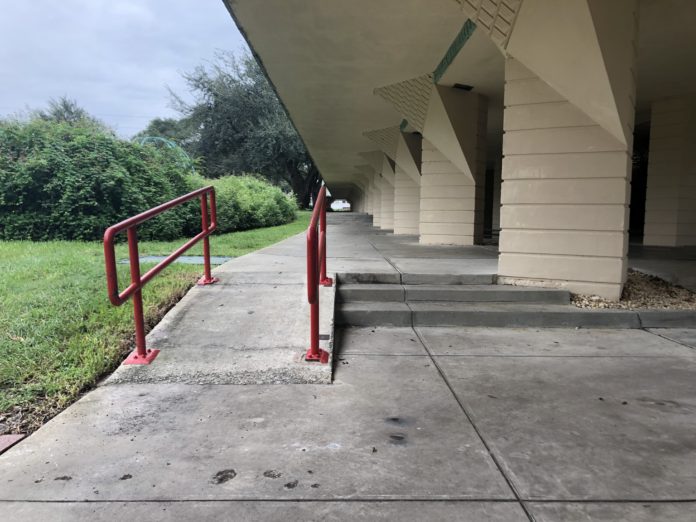
Kenzie Carlson and Vanessa Hart
Students at Florida Southern College have become concerned with accessibility issues on campus.
“Ordway is an area on campus I feel like is very inaccessible,” junior Grace Seaborn said. “There are a lot of stairs without handrails and I’ve only seen a few ramps.”
One of the least accessible areas is Ordway. Not only does it have many stairs but it also lacks ramps in some areas, making it impossible or nearly impossible for students using mobility aids such as wheelchairs to get around the area.
“If someone using a mobility device, such as a 4 mph mobility scooters, is unfamiliar with navigating the campus, it can be a challenge to confidently plot a course along the accessible paths,” Associate Vice President for Student Support Dr. Marcie Pospichal said. “During traditional Face-to-Face Orientations, before classes begin, we guide individual students who use wheelchairs from their residence to classes to familiarize them with accessible paths.”
Pospichal says that the Student Support Office does what they can to “modify the space to become more accessible.”
“For example, we have huge “Mobi Mats” that are rolled out onto terrain that is not accessible to wheelchairs (e.g., grass, gravel) to improve access to those opportunities,” Pospichal said.
Ramps and stairs aren’t the only thing that prevent accessibility for students on campus, some restrooms are inaccessible for wheelchairs, such as the restrooms near the Undercaf which have two doors close to each other which can be tough for someone using a wheelchair to navigate.
“We absolutely want everyone to have access to restroom use,” Pospichal said. ”In cases where a location may not have a wheelchair-accessible restroom (e.g., the Hollis Room), we arrange for access to a nearby, accessible restroom.”
Being a historical campus, Florida Southern has many older buildings on campus which do not always have things like elevators or automatic doors.
“The college is always working to build access, both directly and indirectly,” Pospichal said. “I believe we have the creativity, ingenuity, and good will to improve access in ways that also preserve our important historical heritage.”
To improve accessibility on campus, FSC could add more accessible restrooms, flat/paved sidewalks, more automatic doors in buildings including dorms and academic buildings, and ramps that are better implemented throughout campus.
“I think campus accessibility could be improved by reaching out to students and faculty and getting their opinions on the accessibility of campus,” Seaborn said. “For me personally, I think more staircases could have a handrail, there could be more ramps and the sidewalks could be renovated so they were not as uneven.”
Dr. Pospichal said that communication is key in identifying needs.
“If there is a barrier to access, please report this to my office,” Pospichal said. “We will respond timely to find a solution.”
Kenzie’s Perspective
I have a condition called Cerebral Palsy which causes my brain to not always send the correct signals to my legs and leaves me with tight muscles in my legs and feet.
As a result of this, I struggle with tripping and falling on even the flattest of ground at times.
I also struggle with walking long distances, meaning that at times I use a manual wheelchair to get from one place to another on campus.
I find that one of the hardest paths to navigate on campus isn’t one where stairs or not having ramps is an issue.
For me, the hardest path, whether I am utilizing a mobility device or not, is the path across the street from the caf that goes up next to the wellness center and the green.
This path is a very steep ramp and the concrete has been carved into so it isn’t smooth, leading to tripping hazards and uneven footing which can be dangerous for anyone, whether they are using a mobility device or not.
Vanessa’s Perspective
I’ve had cerebral palsy my whole life, due to a stroke shortly after birth. I am unable to walk and spend most of my time in a wheelchair. If someplace is not wheelchair accessible, it causes major problems for me.
I wasn’t truly aware of the challenges this campus provided for wheelchair users, as this is my first semester. Many times the ramps are tucked away and not easily visible.
The fountain near the library is surrounded by stairs. This means I have to go through the parking lot just to get to the other side.
Having to go across crosswalks makes me feel unsafe. It is highly unlikely that most drivers see me since I’m sitting down. I know Campus Safety can be called, but I don’t always want to have to call for help. People with disabilities value their independence.







